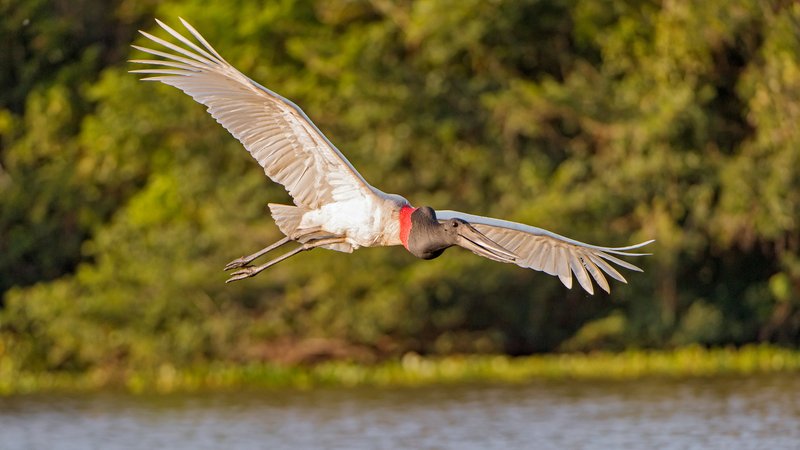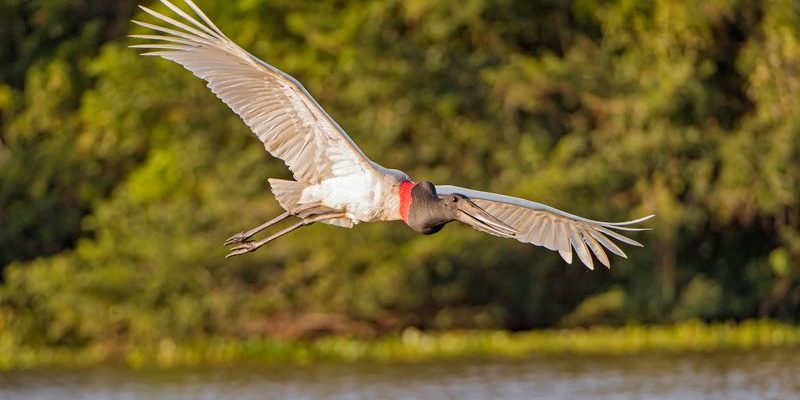
Imagine standing on the edge of a serene wetland, where the sun paints the sky in shades of orange and pink. Suddenly, a giant bird swoops gracefully down, its massive black and white wings spread wide. Meet the Jabiru, one of the tallest stork species in the world! These remarkable birds, often seen in parts of Africa, Australia, and Central America, are striking both in appearance and behavior.
The Jabiru, with its long legs and impressive height, can reach up to 5 feet tall! They have a distinctive appearance with a large, robust beak, perfect for catching prey. You might think of them as the gentle giants of the wetlands, effortlessly gliding through the air or wading through shallow waters in search of food. Their presence is not just a treat for the eyes; it plays a vital role in their ecosystems.
As we dive deeper into the world of Jabirus, you’ll learn about their habitats, diets, breeding habits, and much more. This bird is a fascinating example of how nature adapts and thrives, and there’s so much more than meets the eye!
Physical Characteristics
The Jabiru is renowned for its stunning size and unique features. Standing tall with long legs, they can be quite a sight! Adult Jabirus typically measure between 4.5 to 5.5 feet in length and have a wingspan of about 8 to 10 feet. Their striking black and white plumage contrasts beautifully with their vibrant red throat pouch, making them easy to identify. But it’s not just their size that stands out; their beak is one of the longest among storks, measuring approximately 10 to 12 inches!
These birds wear their feathers like a badge of honor. Adult Jabirus have predominantly white bodies with black wings and necks. Young birds, on the other hand, might not show the same vibrant colors until they mature. This gradual change is nature’s way of helping them blend into their surroundings, making it easier to evade predators during their early years.
You might wonder how these huge birds manage to stay in the air. The Jabiru’s long, broad wings allow it to soar gracefully. They rely on thermal updrafts to lift them effortlessly into the sky, conserving energy while hunting for food below. Watching a Jabiru take flight is nothing short of awe-inspiring, as they glide smoothly across the horizon with an elegance that belies their size.
Habitat and Distribution
The Jabiru has a preference for wetland habitats, thriving in areas such as swamps, marshes, and riverbanks. In Australia, you can find them in the northern regions where these environments are rich with fish and other aquatic life. Their habitat choice is crucial, as it provides ample opportunities for foraging. In regions like Africa and Central America, they also favor similar wetland ecosystems, utilizing both freshwater and brackish waters.
When it comes to distribution, Jabirus are not shy about their range. In Australia, they are often spotted in large numbers, particularly in the northern territory. Conversely, their presence in Africa is widespread, especially in the savannah wetlands. There’s something magical about seeing these birds congregate in their natural habitats, where they create a harmonious balance within the ecosystem.
Interestingly, Jabirus are migratory to some extent. In search of optimal food sources and breeding grounds, they may travel significant distances. This adaptability is key to their survival, allowing them to thrive across diverse landscapes and changing environments. It’s not just about where they live; it’s about how they adapt to the world around them!
Feeding Habits
What does a Jabiru like to eat? You might imagine them snacking on insects or seeds, but these storks primarily dine on fish, frogs, and small invertebrates. With their long legs, Jabirus wade through shallow waters, using their keen eyesight to spot potential meals. When they see a target, they strike with their impressive beaks, making quick work of capturing their prey.
Jabirus are opportunistic feeders, meaning they’ll take advantage of whatever food is available. They can also be seen scavenging around wetlands, picking at leftovers from other predators. This adaptability helps them thrive in their various habitats, allowing them to survive even in less-than-ideal circumstances. It’s fascinating to see how these birds can make the most of their environment!
Some might think that hunting is an easy task for these magnificent birds, but it requires skill and patience. They often stand still for long periods, waiting for the perfect moment to strike. This method is not only effective but also showcases the Jabiru’s unique approach to hunting. When you witness a Jabiru in action, it becomes clear that their feeding habits are just as captivating as their appearance.
Breeding and Nesting
The breeding season for Jabirus typically occurs during the rainy season when food is abundant and conditions are favorable. These birds are known for their remarkable courtship displays, involving elaborate dances and calls. Once a pair has formed, they work together to build a large nest made of sticks and reeds, often situated in tall trees or on elevated platforms near water bodies.
The female Jabiru usually lays between 2 to 4 eggs, which both parents take turns incubating for about 30 days. Once the chicks hatch, they are born with a strong instinct to feed and grow quickly. This rapid growth ensures that they can fend for themselves in just a few months, ready to face the world around them. Watching young Jabirus learn to stretch their wings and take their first flights is a beautiful sight!
Interestingly, Jabirus are known to be quite protective of their nests. They will defend their territory against potential threats, showcasing a fierce parenting instinct. The bond between the parents is strong, with both taking on the responsibility of raising their young. This level of commitment is a testament to the species’ survival in a challenging world.
Conservation Status
As beautiful and iconic as the Jabiru is, it does face threats from habitat loss and environmental changes. Wetland destruction due to agriculture, urbanization, and climate change significantly impacts their populations. These changes can lead to decreased food sources and suitable nesting sites, making survival increasingly difficult. Conservation efforts are essential to protect these majestic birds and their habitats.
Organizations around the world are working diligently to raise awareness about the importance of preserving wetlands. By protecting these vital ecosystems, we can ensure the survival of not just Jabirus but countless other species that rely on these habitats. Public education about sustainable practices can also make a significant difference in preserving the environment for future generations.
It’s crucial that we support initiatives focused on conservation and habitat restoration. Every effort counts in helping the Jabiru and other wildlife thrive. You might even find local projects or organizations in your area that you can contribute to or volunteer with, making a tangible difference in protecting these wonderful creatures.
Interesting Facts
Did you know that the Jabiru is not just a bird, but a symbol of biodiversity? These storks play a pivotal role in their ecosystems, helping to maintain balance within wetland environments. They’re often seen as indicators of environmental health, meaning their presence can reflect the state of their habitats.
Another fun fact: Jabirus are social birds! You might spot them in groups, especially during feeding or nesting seasons. This social behavior helps them locate food and provides safety in numbers. Watching a flock of Jabirus take to the sky is an unforgettable experience, revealing the beauty and grace of these magnificent birds.
Finally, the Jabiru is known for its impressive longevity, with some individuals living up to 35 years in the wild! This longevity adds another layer to their fascinating life story, showcasing the resilience and strength of this remarkable species.
| Characteristic | Details |
| Height | 4.5 to 5.5 feet |
| Wingspan | 8 to 10 feet |
| Diet | Fish, frogs, small invertebrates |
| Breeding Season | Rainy season |
| Eggs per Clutch | 2 to 4 eggs |
| Lifespan | Up to 35 years |
FAQ
What is the Jabiru’s primary habitat?
The Jabiru mainly inhabits wetlands, including swamps, marshes, and riverbanks. They prefer areas where they can find ample food and nesting sites, thriving in both freshwater and brackish environments.
How do Jabirus catch their food?
Jabirus catch their food by wading through shallow waters, using their sharp eyesight to identify prey such as fish and frogs. They strike quickly with their long beaks to capture their meals.
Are Jabirus social birds?
Yes, Jabirus are known for their social behavior. They often gather in groups, especially during feeding or nesting seasons, which provides safety and helps them locate food more efficiently.
How long do Jabirus live?
Jabirus can live up to 35 years in the wild, showcasing their ability to thrive in their various habitats over time.
How do environmental changes affect Jabirus?
Environmental changes, such as habitat loss and climate change, can significantly impact Jabirus by reducing their food sources and suitable nesting sites, making it harder for them to survive.
What can I do to help Jabirus?
You can help Jabirus by supporting local conservation initiatives that focus on protecting wetlands. Raising awareness about the importance of these ecosystems can also make a difference.
Do Jabirus migrate?
While Jabirus are not fully migratory, they may move to find better food sources and breeding grounds, especially in response to changing environmental conditions.
What is the Jabiru’s breeding behavior?
During the breeding season, Jabirus engage in courtship displays, build large nests, and take turns incubating their eggs. Both parents are involved in raising their young, which is crucial for their survival.
How can I identify a Jabiru?
You can identify a Jabiru by its tall stature, long legs, black and white plumage, and distinctive red throat pouch. They are among the tallest storks in the world, making them easily recognizable.
Are Jabirus endangered?
While Jabirus are not currently classified as endangered, they do face threats from habitat loss and environmental changes. Conservation efforts are essential to protect their populations.
What role do Jabirus play in their ecosystem?
Jabirus play a vital role in maintaining the balance of wetland ecosystems, helping control fish and amphibian populations and indicating the health of their habitats through their presence.

